Trăim vremuri grele, iar călătoriile nu par să mai fie la
fel de distractive ca acum câteva luni. Chiar și cu atât de cunoscutele
restricții legate de Covid-19, oamenii se obișnuiseră cu ideea de a purta măști
și de a arăta documente, vaccinuri, teste și așa mai departe. Normalitatea se
putea schimba în câteva secunde.
Totuși, un conflict militar nu era parte din plan. Nimeni nu ar fi crezut că știrile sunt reale, doar că sunt, iar noi ne aflăm mai aproape de realitatea neagră decât ne-am dori.
Cu toate astea, nu mă aflu aici ca să vă vorbesc despre asta.
M-am întors pentru că îmi doresc să vă vorbesc despre ceva la care mă consider
mai pricepută. Locațiile ascunse, misterioase și mai puțin cunoscute lumii
sunt, poate, subiectul meu preferat de pe acest blog, așa că a trebuit să vin
cu ceva interesant și inedit pentru articolul de astăzi. Sunt încântată să vă
arăt în sfârșit câteva locuri frumoase pe care le-am descoperit recent în
propriul meu oraș, București. Știu foarte bine că oamenii au nevoie să audă
orice fel de știri care să nu includă crime de război, așa că, fără a ne mai
lungi, să începem!
În primul
rând, aș dori să încep cu o întrebare. Ați auzit vreodată de „Killing Eve” sau l-ați vizionat?
Pentru cei care nu știu despre ce e vorba,
este un serial și multe dintre scenele sale au fost filmate în
România (mai ales în București, dar și în locuri precum Viscri - patrimoniu
UNESCO sau Snagov - locul în care este îngropat Vlad Țepeș). Nu o să
menționez aici intriga deoarece este puțin complicată, dar ideea este că serialul ne ajută să ne dăm seama cât de versatil este Bucureștiul. Unele scene au
fost filmate în București, dar de fapt prezentate ca Paris, Berlin, Sofia sau
Moscova.
România în
general (și Bucureștiul în special) a fost odinioară una dintre porțile dintre
Est și Vest, iar acest lucru încă se mai poate observa și astăzi. Contrastele sunt evidente și uneori brutale, dar trebuie să le acceptăm ca atare dacă ne dorim să locuim aici. Bucureștiul nu este și probabil nu va fi
niciodată la fel de cizelat ca alte orașe europene, dar există ceva la el care
mă face să vreau să-l explorez mai mult. Nici măcar nu știu care dintre cartierele armenesc și evreiesc, vibe-ul parizian din perioada
interbelică sau cafenelele moderne mă fascinează mai
mult. Mă cunoașteți foarte bine, astfel că știți cât de mult apreciez diversitatea culturală.
Istoria ne-a învățat că politica și afacerile externe ale unei țări au făcut-o mai mult sau mai puțin dezvoltată. Cu cât o țară este mai aproapiată de restul lumii, cu
atât este mai puternică și prosperă. Acest lucru se datorează faptului că legăturile culturale sunt cel mai important atuu pe care îl avem ca oameni.
[EN] We're living rough times and travelling doesn't seem to
be as fun as it used to a few months ago. Even with the so well-known Covid-19
restrictions, people got used to the idea of wearing masks and showing off
documents, vaccines, tests and so on. Normality changed in a second.
However, military conflicts weren't part of anyone's schedule. Nobody believed
this was real. But it is and we're closer to this than we would like to.
Anyway, I'm not here to talk about this. I'm back because I
want to talk to you about something I'm actually better at. Hidden gems are my
favourite subject on this blog so I kind of had to bring something great to the
table for today's article. I'm excited to finally show you some nice spots I've
recently discovered in my own city, Bucharest. I know best that people need to
hear any sort of news that doesn't include war crimes so, without further ado,
let's start!
First of all, I'd like to ask you a question. Have you ever heard of "Killing Eve" or have you watched it? (*5 mins silence*).
For those of you who might not know it, it's actually a TV series and many of its scenes were shot in Romania (mostly in Bucharest, but also in places like Viscri - an UNESCO heritage site or Snagov - the town where Vlad the Impaler is burried). I'm not going to mention the plot as it is a bit complicated but the point is that the series kept me thinking about how multitasking Bucharest is. Some scenes were shot in Bucharest but actually presented as Paris, Berlin, Sofia or Moscow.
Romania in general (and Bucharest in particular) used to be one of the gates between the East and the West and it can still be seen nowadays. The contrasts are somehow brutal from time to time but you must embrace it in order to live here. Bucharest isn't and will probably never be as polished as other European cities but there is something about it that makes me want to explore it more. I'm not even sure whether it is the Armenian and Jewish neighbourhoods, the Parisian chic vibe from the Interwar period or the cool, modern coffee shops and bars that fascinate me more. You know me guys, you know how much I appreciate cultural diversity. History taught us that a country's foreign affairs made them weaker or stronger. The closer a country is to the rest of the world, the more developed it is. This is because networking is the most powerful tool we have as humans.
1. Muzeul de Artă
Populară "Dr. Nicolae Minovici "/ The "Dr. Nicolae Minovici" Folk Art Museum
Amplasată în nordul Bucureștiului în drum spre aeroport (mai exact în dreptul Fântânii Miorița), clădirea poate văzută de toată lumea și, totuși, puțini sunt cei care o observă. Mereu m-am întrebat care ar putea fi povestea acestui loc și am fost șocată când am
aflat că este de fapt un muzeu de artă populară. Frații Minovici făceau parte dintr-o
familie bogată de descendență sârbo-macedoneană și toți erau cunoscuți pentru
că studiau și excelau în medicină. Unul dintre ei, Mina Minovici, a fondat
primul Institut de Medicină Legală din România.
Conacul în stil neoromânesc a aparținut însă fratelui lui Mina,
Nicolae Minovici, iar colecția sa de artă populară este destul de
impresionantă. Dacă sunteți interesați de el, este situat într-un cartier
liniștit și este înconjurat de un parc destul de spațios și îngrijit. Pentru studenți biletul costă 5 lei.
[EN] Located in Northern Bucharest on the way to the
airport, this building can be seen by everyone but yet not be noticed by
many. I've always wondered what that building was and I was shocked when I
found out it was actually a Folk Art Museum. The Minovici brothers were part of a
wealthy family of Serbian- Macedonian descedancy and they were all known for
studying and excelling in medicine. One of them, Mina Minovici, founded the
first Romanian Institute of Forensic Medicine.
The neo-Romanian style mansion belonged to Mina's brother
though, Nicolae Minovici, and his Folk art collection is quite impressive. If
you're interested in it, it's situated in a quiet neighbourhood and is
surrounded by a lovely park. It costs 5 lei/1 euro/1,1$ to visit the whole area (students' price)












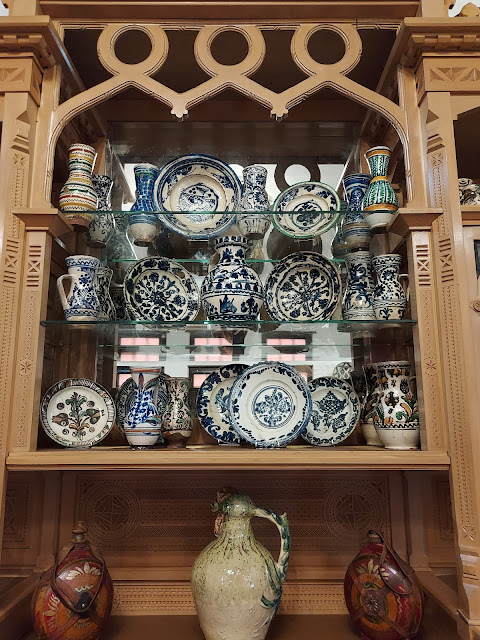
















2. Muzeul de Artă Veche Apuseană Dumitru Furnică Minovici / Western Old Art Museum Dumitru Furnică Minovici
Poziționat în spatele muzeului sus-menționat, clădirea în stil gothic terțiar/perpendicular englezesc - Tudor - și cu inserții franțuzești și venețiene a aparținut Ing. Dumitru Furnică Minovici care a fost, printre altele, colecționar de artă apuseană medievală și modernă. Interesant este că tot mobilierul și aranjamentul a fost achiziționat din anticariate și licitații din întreaga Europă. Din ce ne-a povestit ghidul, destule personalități de la Hollywood ar fi luat cina aici, dintre care Alec Baldwin și Salma Hayek. Intrarea a fost gratuită, iar pentru un conac construit în anii 1940 ce are în componența sa cele mai vechi vitralii de pe teritoriul României, merită tot efortul.
[EN] This building is situated right behind the first museum and it once belonged to engineer Dumitru Furnică Minovici, a descendant of the Minovici family. The mansion was built in gothic and Tudor-British styles in the 1940s. The owner was also a collector of medieval and modern Western art. In fact, the furniture was purchased from antique shops and auctions from all across Europe. The guide told us that some Hollywood stars had eaten dinner in this mansion, including Alec Baldwin and Salma Hayek. It also has the oldest stained glass windows in Romania. The entrance is free so it's worth visiting in my opinion.















3. Muzeul de Artă "Frederic Storck și Cecilia-Cuțescu" / "Frederic Storck și Cecilia-Cuțescu" Art Museum
Ea, Cecilia - pictoriță; El, Frederic - sculptor. Așa aș putea să rezum această locuință-atelier în stil oriental care sugerează foarte clar atmosfera din familia de artiști. Soția a pictat pereții casei, iar soțul a sculptat ornamentele și zidurile. Biletul de student costă 5 lei.
[EN] Wife and husband, painter and sculptor. This is how I can sum up this Oriental style workshop mansion. Cecilia obviously painted the walls of the house and Frederic added the sculptures and the reliefs. It is indeed very cozy and artsy. It also costs 5 lei/1euro/1,1$.
4. Jewish Museum Bucharest
Locul în sine
este uimitor și puteți afla o mulțime de informații interesante despre
comunitatea evreiască din România. Odinioară era destul de numeroasă și răspândită de-a lungul întregii țări. Le admir cultura și felul lor de a fi. Îmi place să învăț
lucruri noi în fiecare zi și mereu v-am încurajat să faceți același lucru aici,
pe blog. Cu toate acestea, trebuie să fiu sinceră cu voi și să vă sfătuiesc să nu faceți poze (cel puțin acelea în care apăreți și voi). V-am promis încă
din 2017 de când am început blogul că voi fi sinceră tot timpul, deși nu-mi place să vorbesc despre lucruri
negative. Scopul meu este să vă fac să zâmbiți și să uitați de problemele de zi cu zi. Totuși, un comentariu mai puțin plăcut al ghidului de acolo mi-a lăsat un gust amar. Din ce am înțeles, s-a simțit jignit de faptul că mi-am făcut poze în
muzeu. Am încercat să remediez situația însă a fost în zadar.
În rest, îl
recomand călduros. Muzeul Evreiesc este situat chiar în mijlocul cartierului
evreiesc și îl puteți vizita gratuit. Clădirea a fost cândva o sinagogă, dar găzduiește muzeul de astăzi încă din anul 1978.
[EN] The place itself is stunning and you get to find out a lot of interesting information about the Jewish community in Romania. It used to be quite numerous and widespread all over the country. I admire their culture and their way of being. I love learning new things everyday and I've always encouraged you to do the same here on this blog. However, I must be honest with you and advice you to not take pictures (at least of yourself). I promised you back in 2017 when I started this blog that I'll be sincere all the time, even though I hate talking about negative things. My goal is to make you smile and forget about your daily problems. I must confess that the local guide's rude comments ruined my entire visit. I somehow managed to offend him for taking a few pictures of myself in the museum. I'm trying to be kind all the time and I felt so bad and guilty about it.
Otherwise, I highly recommend it. The Jewish Museum is located right in the middle of the Jewish quarter and you can visit it for free. It once was a synagogue but it's been a museum since 1978.
Sunt conștientă că publicul meu masculin va fi înnebunit după acest muzeu/această colecție de
mașini. Trebuie să recunosc, e o capodoperă, iar mașinile sunt
incredibile. Întreaga zonă aparține miliardarului român Ion Țiriac, acesta deținând o
gamă vastă de vehicule. De la mașini sport precum Ferrari, Lamborghini,
Porsche, Maserati până la unele elegante precum Rolls Royce, Bentley și
Cadillac. Există, de asemenea, mașini de la începutul secolului XX, motociclete, o mașină de pompieri drăguță și chiar un vagon de popcorn și alune! Preferate mele sunt mașinile Rolls Royce și Bentley. Galeria de mașini este
aparent singura din lume de acest fel care are întreaga colecție Rolls Royce Phantom.
Pentru cei dintre
voi care m-ați urmărit din 2019, știți că am vizitat o atracție turistică
similară în
Málaga și am fost tare impresionată de autenticitatea acesteia.
El Museo Automovilístico y de la Moda este mult mai mare și colecționarul
portughez părea să fie pasionat și de modă, dar nu mă deranjează atâta timp cât
mă pot uita la mașini scumpe în propriul meu oraș. Deloc.
Mai mult, este
accesibil de vizitat. Costă 20 de lei mai exact, dar totul este mai ieftin dacă sunteți studenți ca mine (5 lei/student).
[EN] I'm aware of the fact that my male audience will just go crazy about this museum/car collection. I must admit that this is a masterpiece and the cars are incredible. The whole area belongs to the Romanian billionaire Ion Țiriac and he owns a big range of vehicles. From sports cars like Ferraris, Lamborghinis, Porsches, Maseratis to classy ones like Rolls Royces, Bentleys and Cadillacs. There are also 1900s cars, motorbikes, Range Rovers, a nice fire truck and even a Popcorn & Peanut wagon!!!! My favourite ones are Rolls Royces and Bentleys though. This car gallery is apparently the only one in the world to have the entire Rolls Royce Phantom Collection.
For those of you who have followed me since 2019, you know that I visited a similar tourist attraction in
Málaga and I was so impressed by the authenticity of it. El Museo Automovilístico y de la Moda is way larger and the Portuguese collector seemed to be passionate about fashion as well but I don't mind as long as I can stare at expensive cars in my own city. Not at all.
It's also affordable to visit it. It costs 20 lei/4 euros/4 $ 40 cents per adult to be exact but it's all cheaper if you're a student like me.
6. Casa Ceaușescu / House of Ceaușescu
Sinceră să fiu, nu știu ce să mai cred despre acest muzeu. E minunat și destul de unic din multe
puncte de vedere. Pe de altă parte, e nebunesc când te gândești la cum arată reședința opulentă a celei mai cunoscute personalități politice a României din secolul
XX. Mă intrigă contrastul dintre
această casă și condițiile nu tocmai prielnice de existență cu care se confrunta restul
țării. Casa lui
Ceaușescu este departe de ideologia și regimul pe care le promova și impunea.
Dacă sunteți
interesați de această atracție turistică, trebuie știut că îl puteți vizita doar cu programare. Se va forma un grup turiști și apoi veți fi ghidați prin muzeu. Ei fac tururi ghidate atât în limba română,
cât și în engleză. Costă 40 de lei/adult sau 30 de lei/student.
Câteva aspecte interesante despre acest loc ar fi că majoritatea pieselor de mobilier, de artă și a materialelor utilizate au fost realizate în România. Casa este formată din
147 de camere dintre care 50 pot fi vizitate de turiști. Multe camere sunt
încuiate de autorități, deoarece unele arhive secrete sunt depozitate acolo. Nimeni
nu știe valoarea exactă a conacului deoarece este o informație clasificată de
către Serviciul Român de Informații. Interioarele arată la fel din 1989.
Fiecare dintre cei trei copii avea camerele sale (camerele lui Zoe au fost preferatele mele). Mai puteți vedea piscina, zona spa, dressingurile, grădina interioară, biroul președintelui,
multe camere de zi. În concluzie, puteți vedea multe camere. Grandomania și
cultul personalității se remarcă în fiecare colț de casă.
Vi-l recomand cu mare drag. Este întotdeauna important să ținem cont de istoria noastră recentă și să ne gândim la lucrurile care s-au schimbat sau care au rămas la fel.
Sfat bonus: este
situat în cartierul francez, unul dintre cele mai frumoase cartiere din
București. Puteți face o plimbare și admira clădirile și cafenelele elegante.
[EN] I honestly have mixed feelings about this museum. It is marvellous and quite unique from many points of view. On the other hand, it's scandalous to think about the opulent residency of Romania's best known political personality of 20th century. You probably ask "What is she talking about?". Well...the contrast between this luxurious mansion and the terrible life conditions the rest of country was facing back then is huge. What intrigues me the most is that the house of Ceaușescu is far from the ideology and regime they were promoting and imposing.
If you're interested in this, you should know that you can only visit it by making an appointment. A group of people depending on where you're from will be formed and then you'll be guided throughout the museum. They make guided tours in both English and Romanian. It costs 40 lei/8 euros/8$80cents per adult (of course, it's less if you're a student).
Some cool facts about this place would be that most of its furniture, pieces of art and materials were made in Romania. The mansion consists of 147 rooms out of which 50 can be visited by tourists. Many rooms are locked by the authorities as secret archives are stored there. Nobody knows the total value of the mansion because it's classified information by the Romanian Secret Service. The interiors have looked the same since 1989. Each of the three children had their own rooms (Zoe's rooms were my favourite). You can also see their pool, spa area, dressing rooms, interior garden, the dictator's office, many living rooms. To sum up, you can see many rooms. Their grandomania and cult of personality can be noticed in every aspect of the house.
I highly recommend it. It's always nice to keep recent history in mind and to realize how many things have changed.
Bonus tip: It's located in the French quarter, one the fanciest neighbourhoods in Bucharest. You can take a stroll and admire the classy buildings and cafés.
Asta a fost pentru azi, dragii mei! Sper că ați găsit acest articol interesant și inspirațional! Noi ne vedem curând cu noi aventuri și noi țări! Până atunci, îmbrățișări!
[EN] That was all for today, folks! I hope you find it fascinating and inspiring! See you soon from another country! 2022 adventures have just begun (With a 4 months delay, I know!)
















































































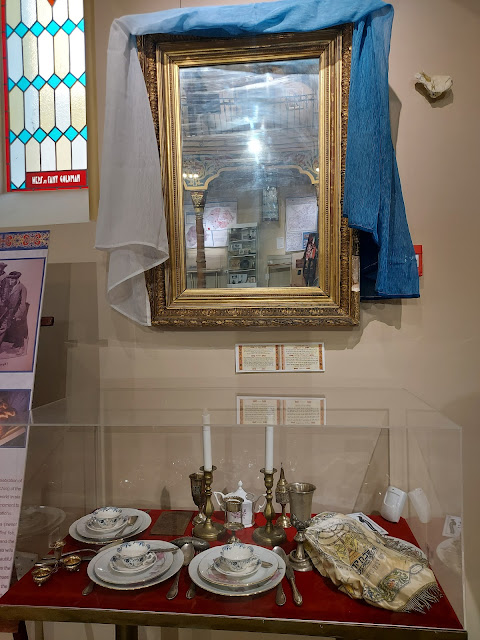

























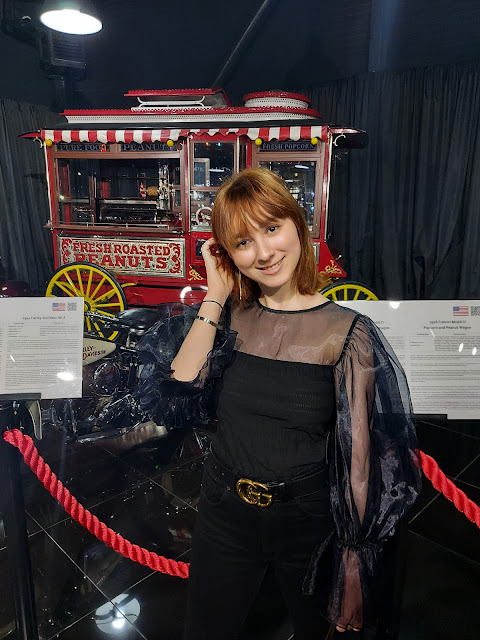


















.jpg)






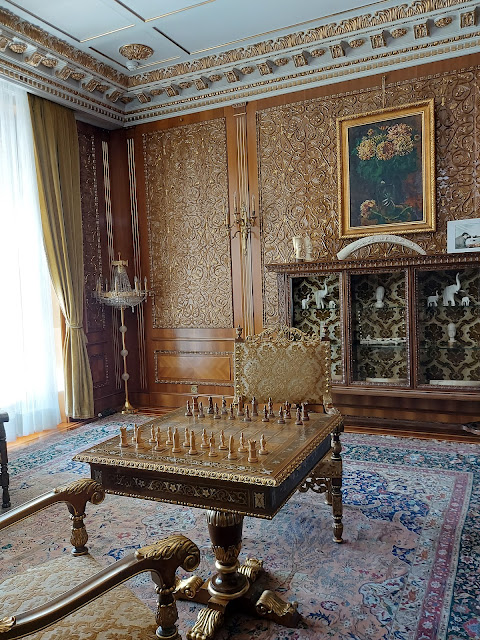










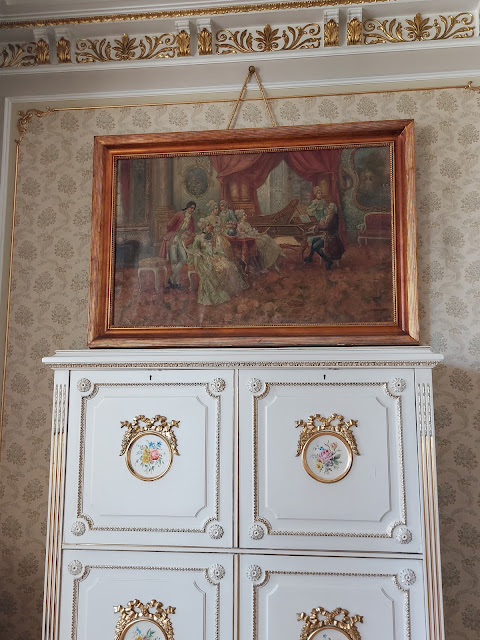




























Comments
Post a Comment